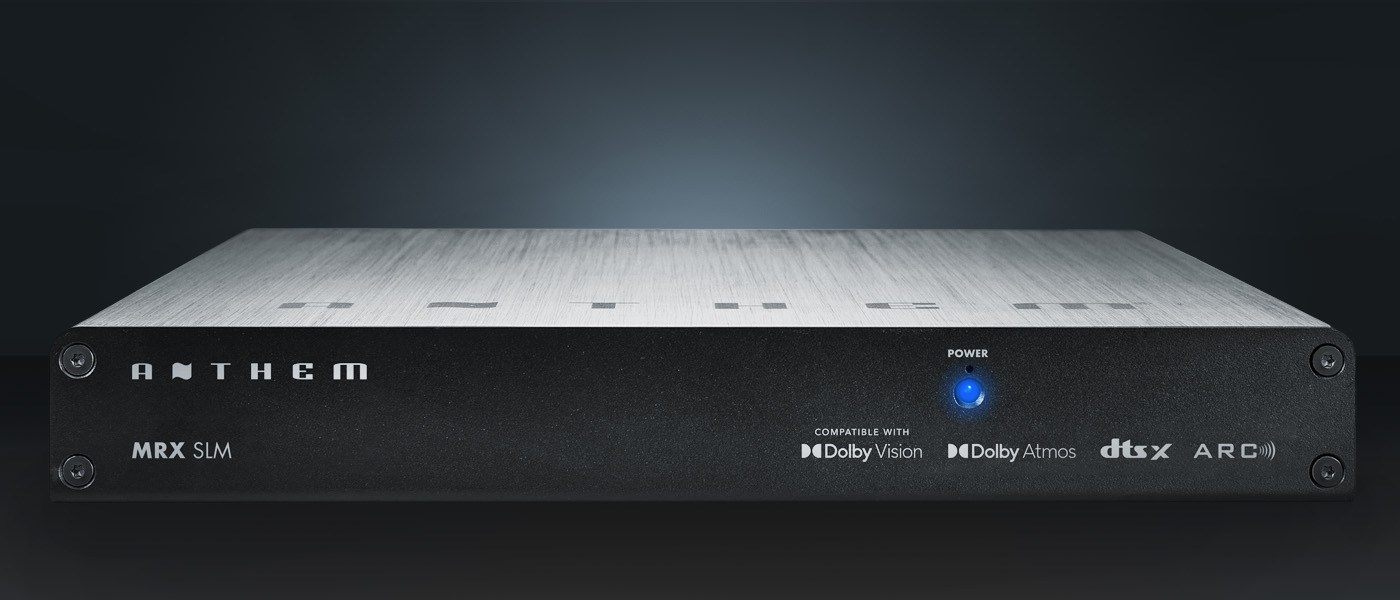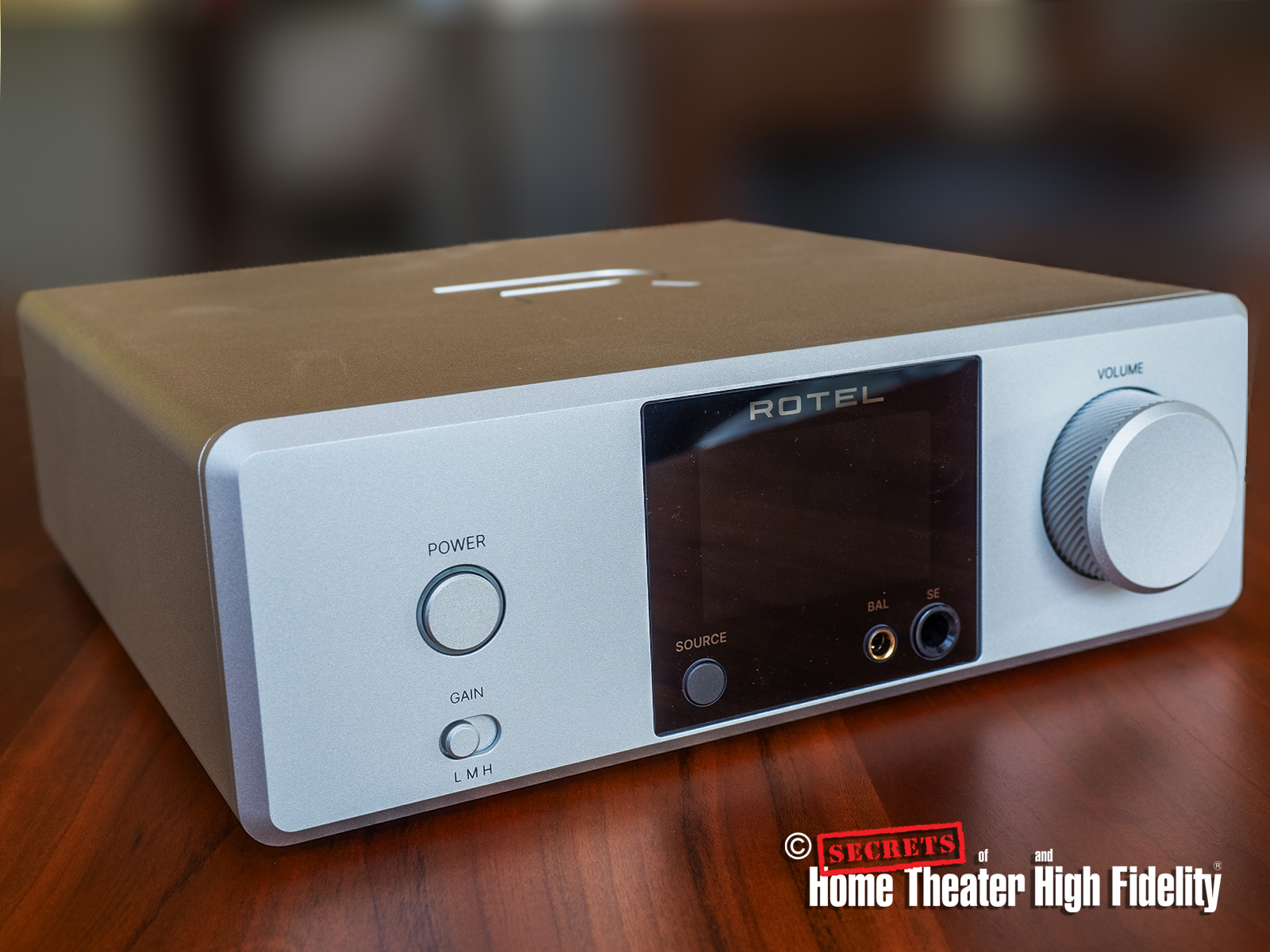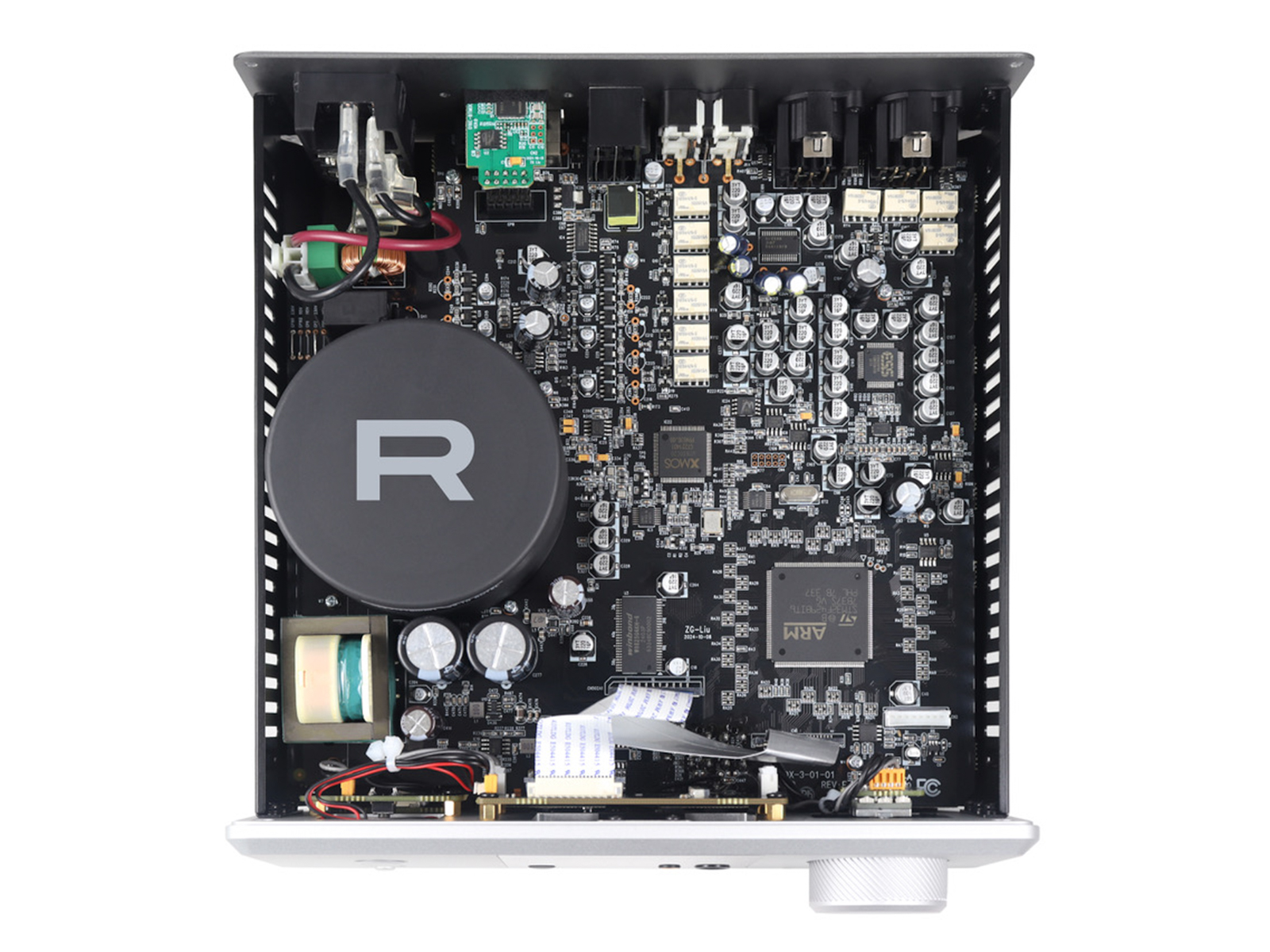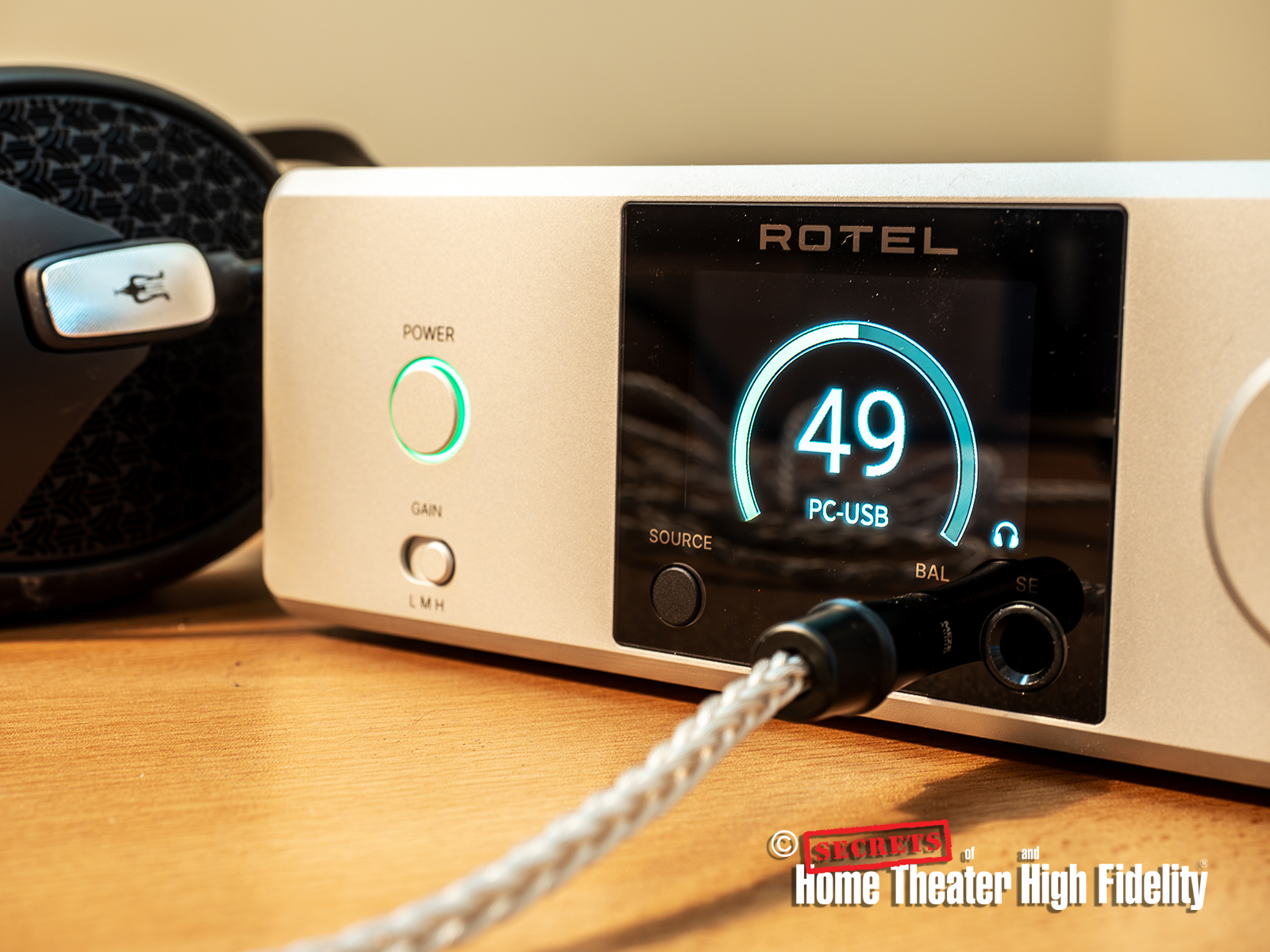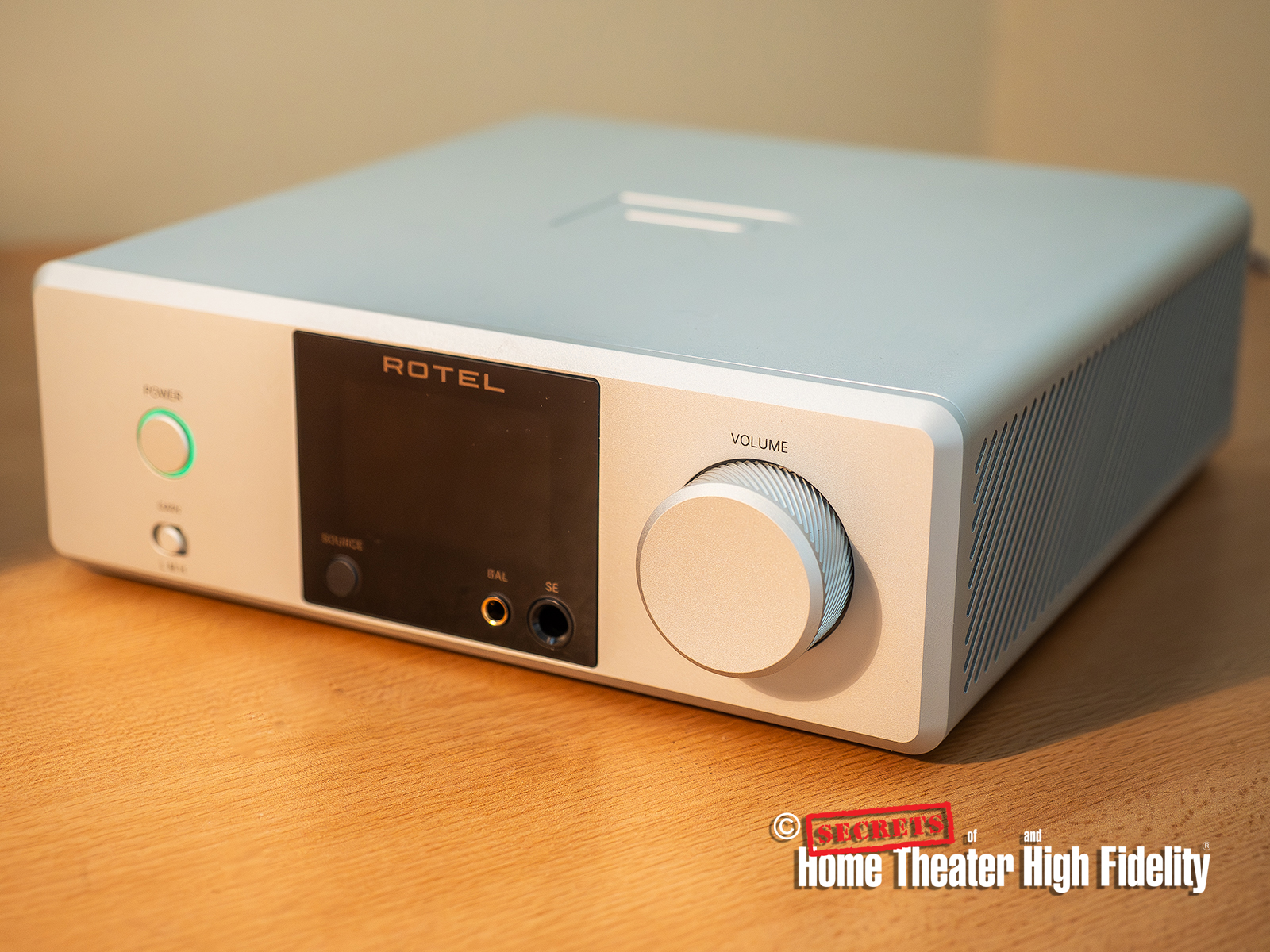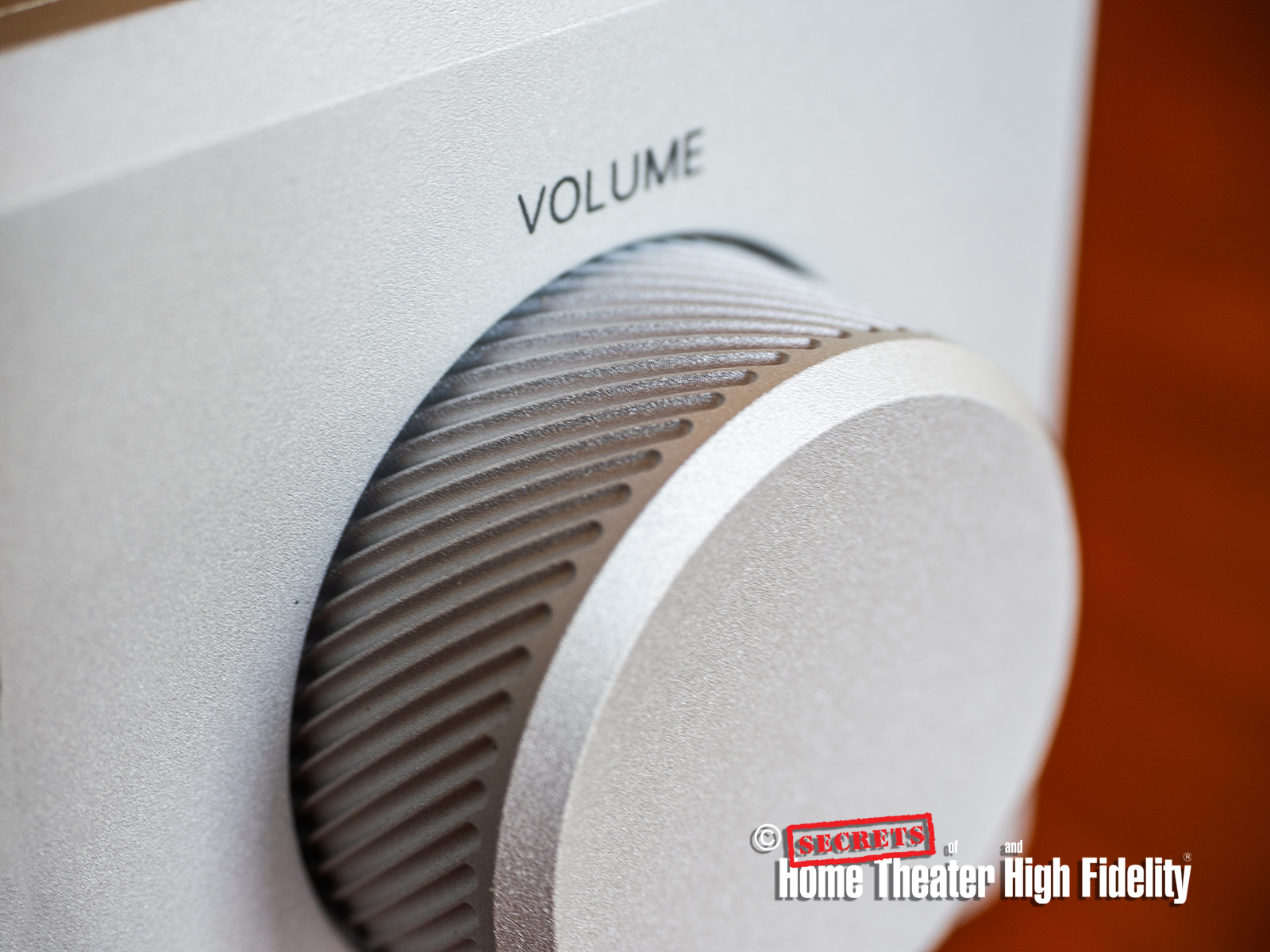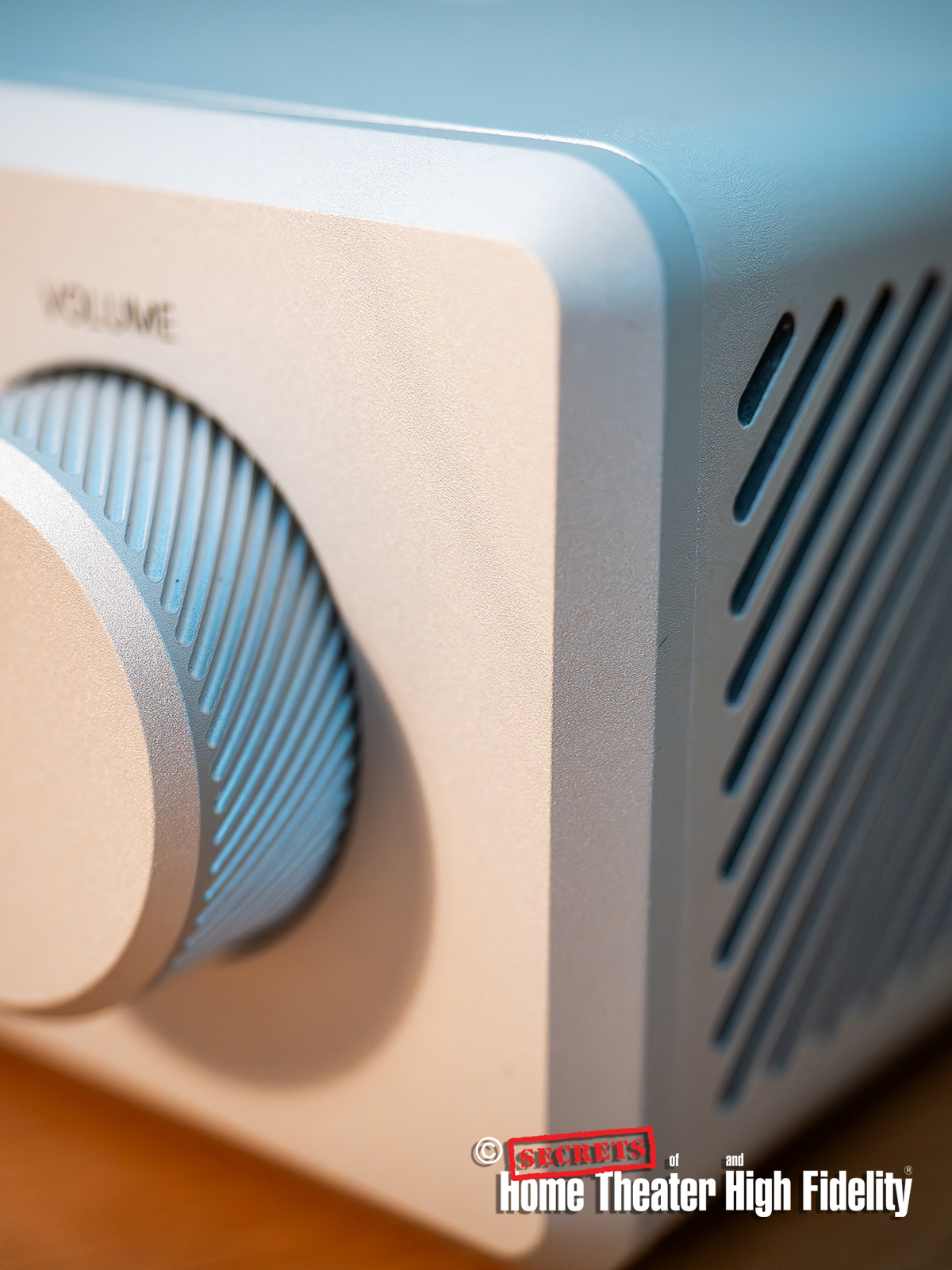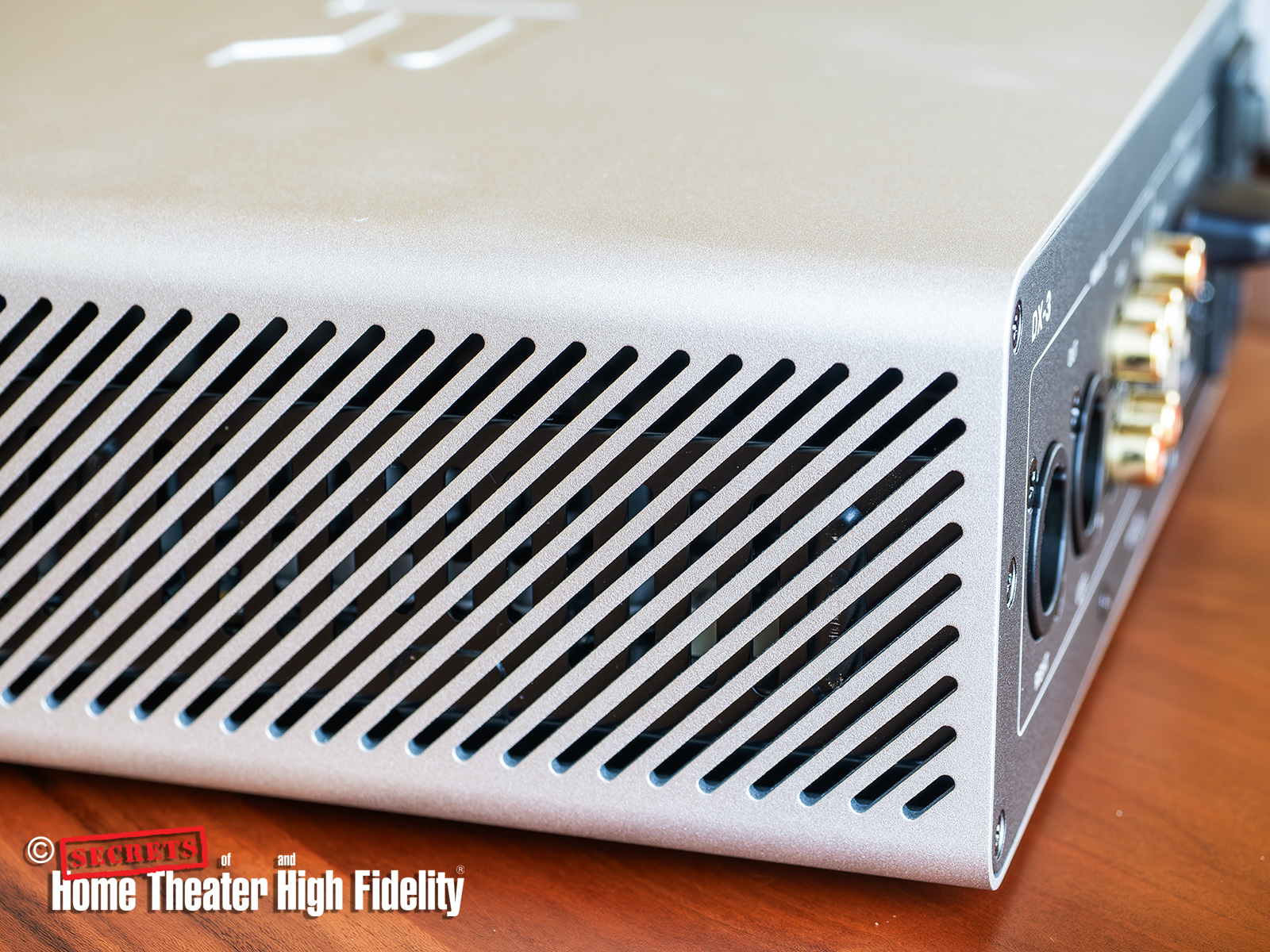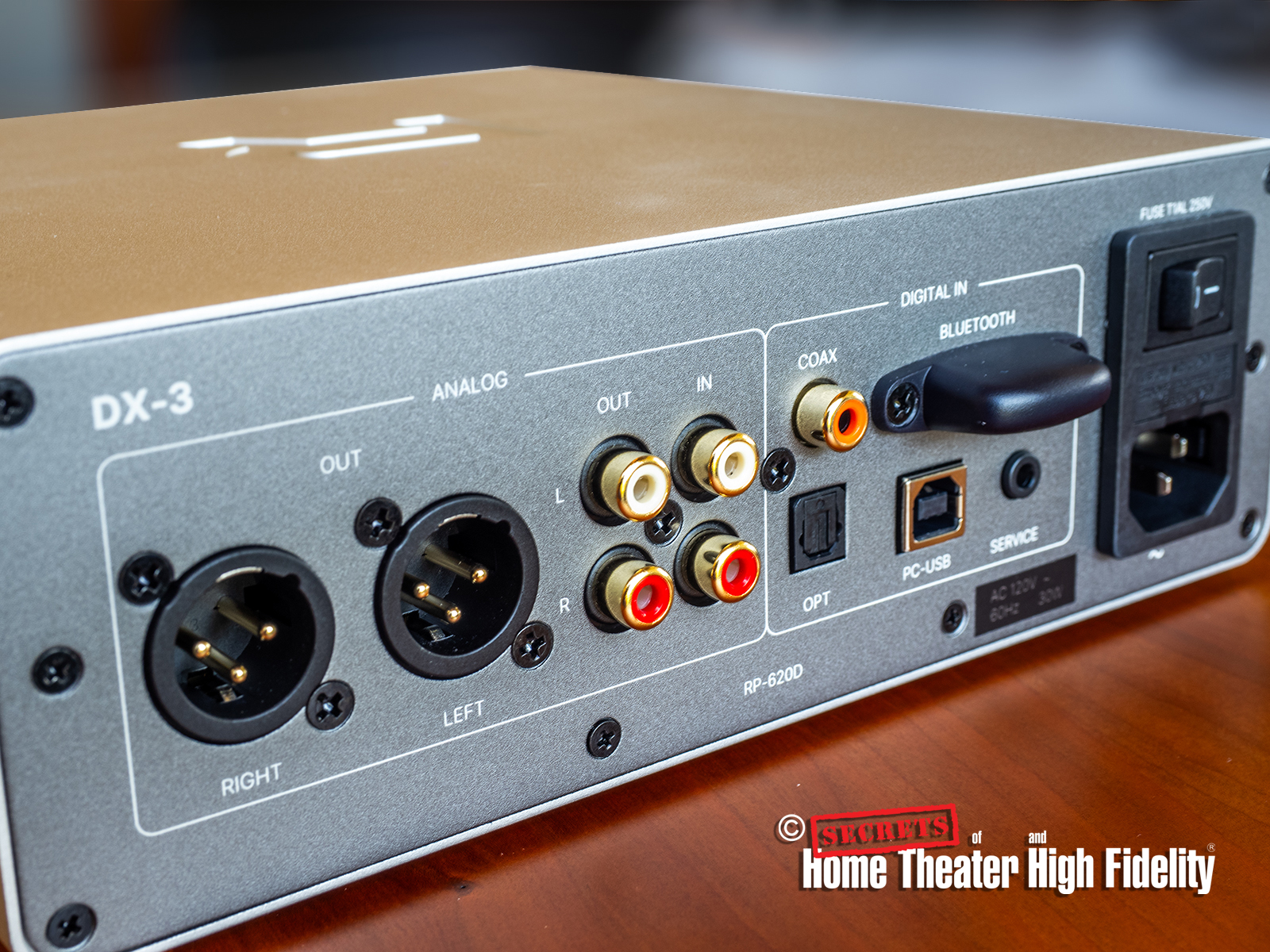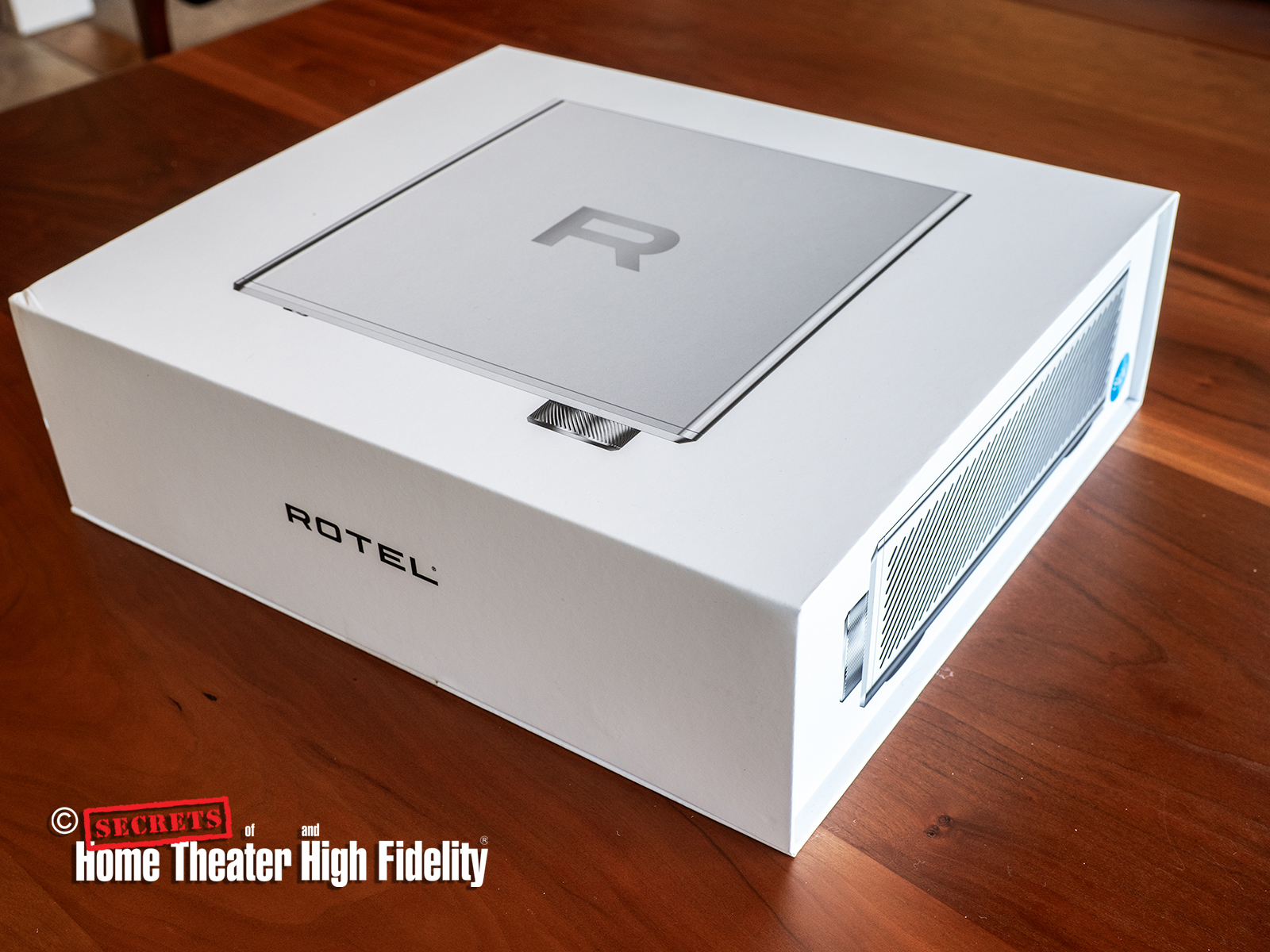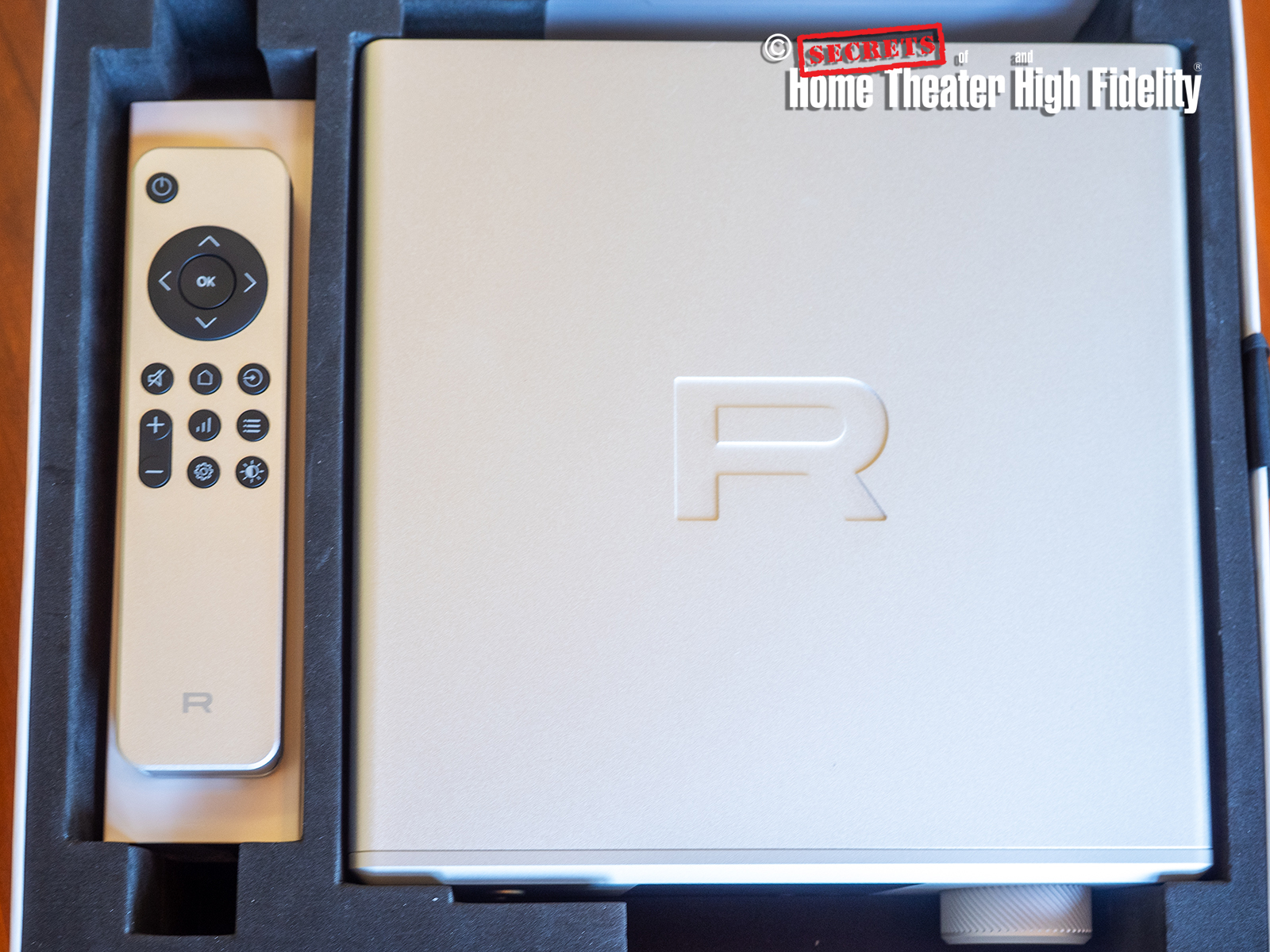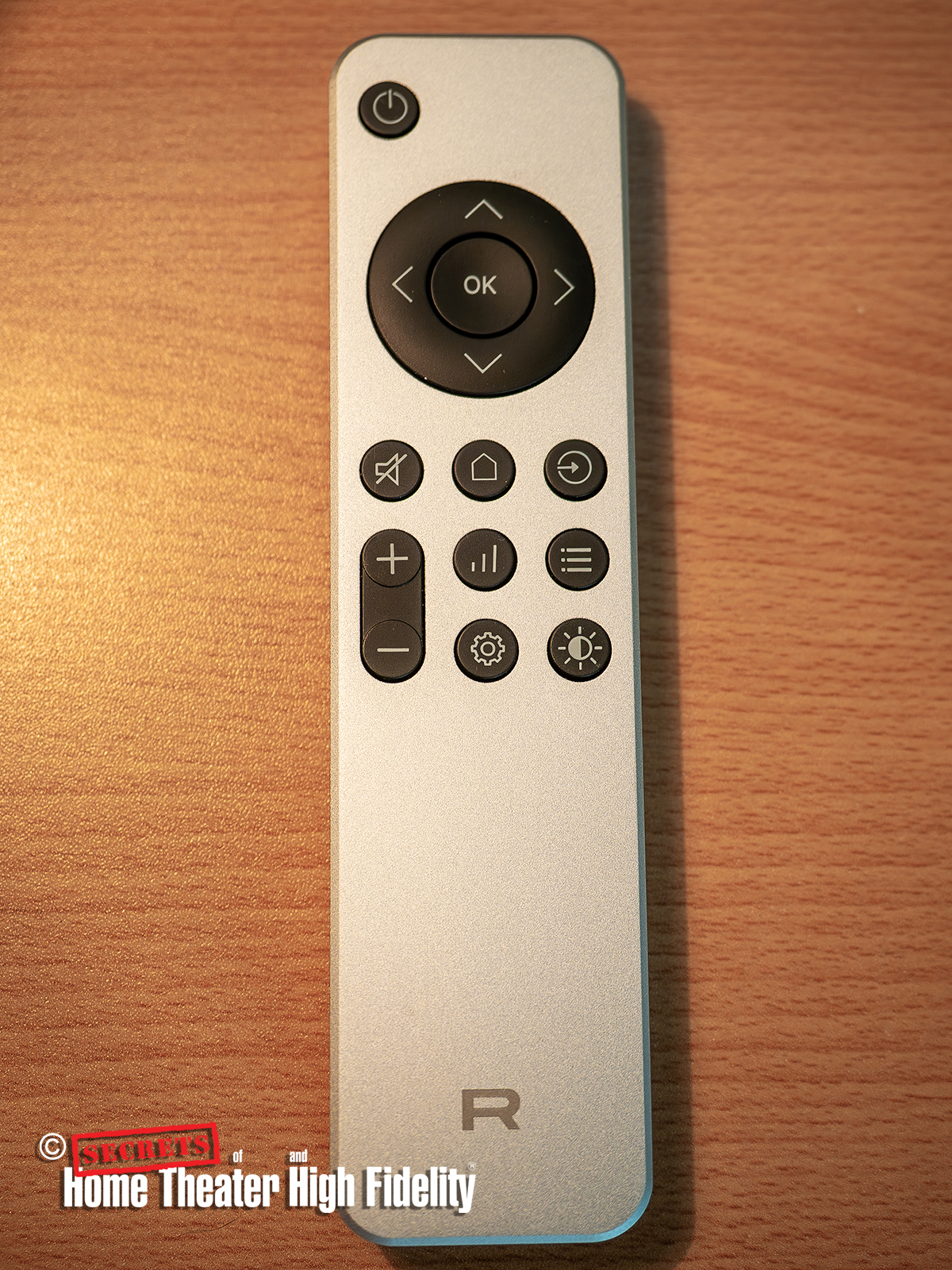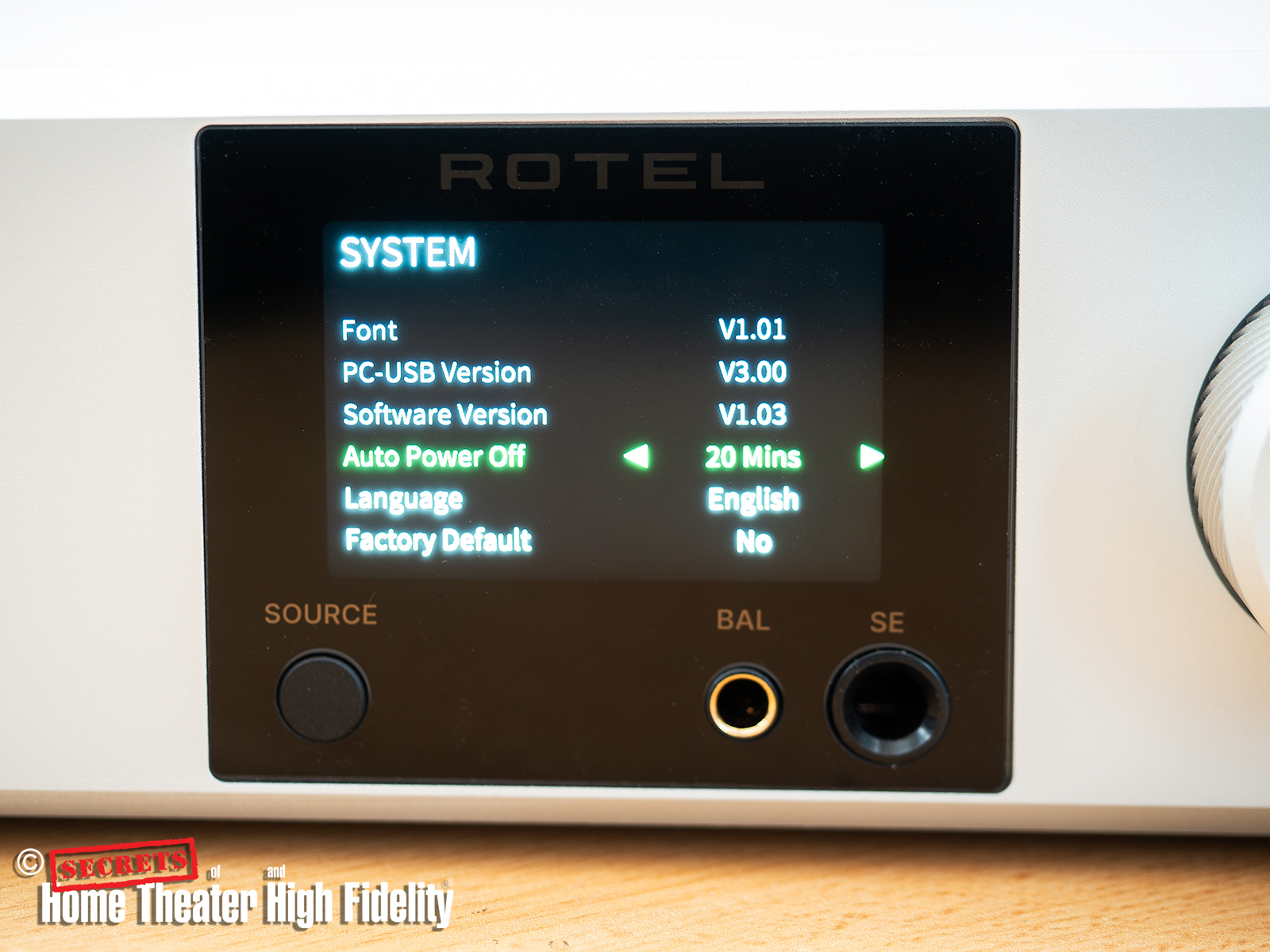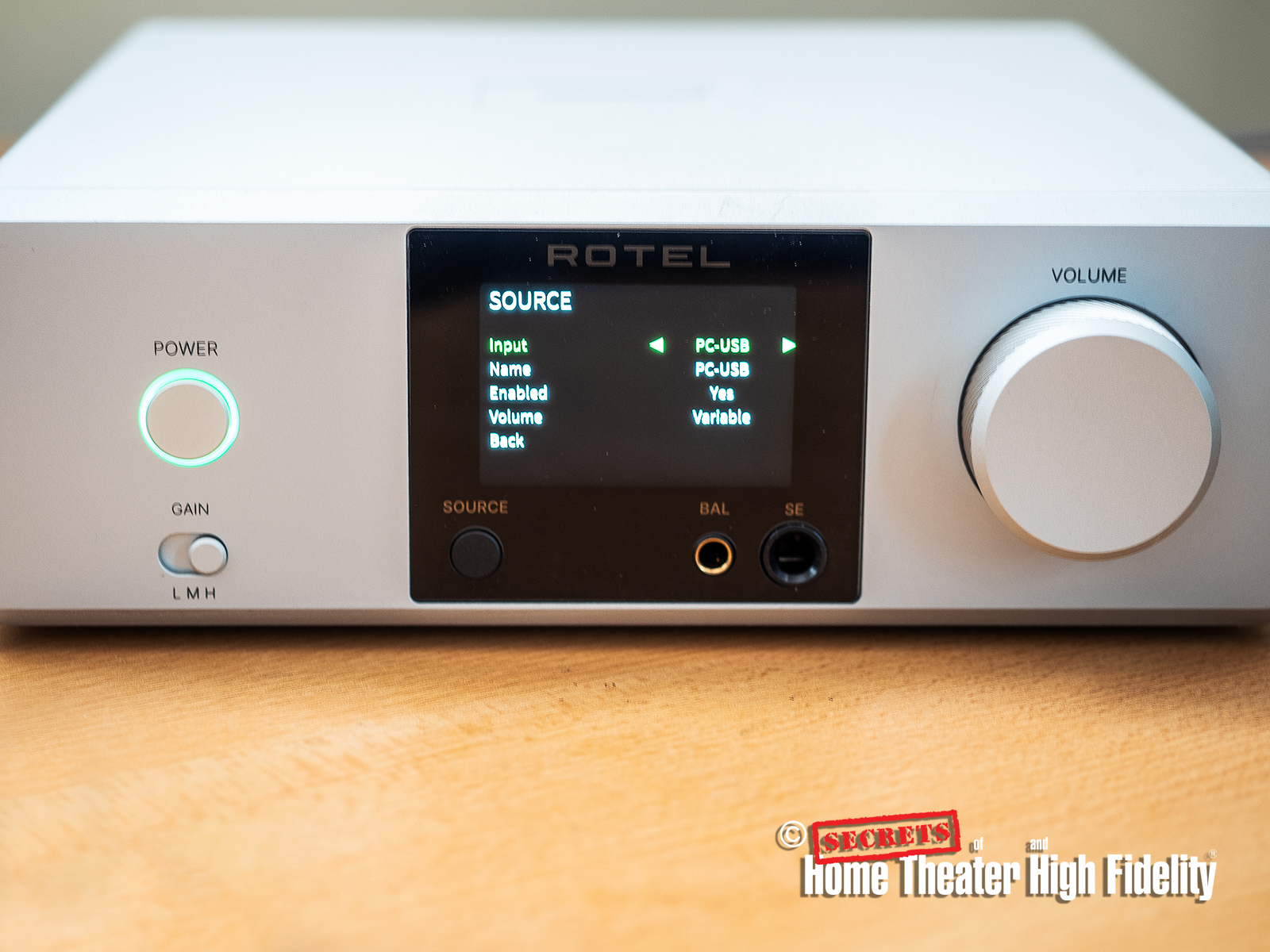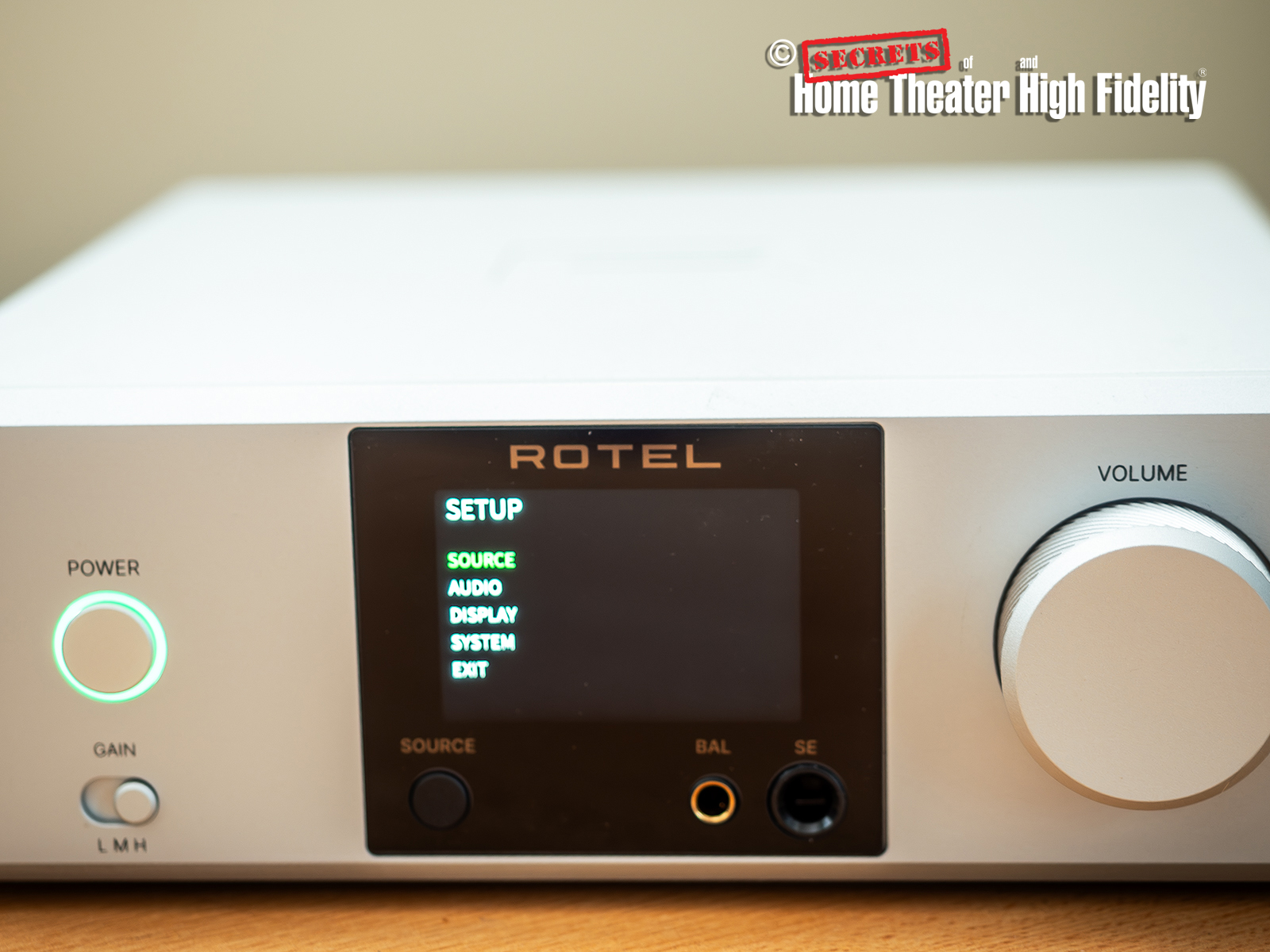But one name, Rotel, has quietly stepped in with the DX-3, a fully balanced headphone DAC/Amp/Preamp. Rotel, the 64-year-old Japanese manufacturer of audio products has brought its considerable experience building custom toroidal transformers to the headphone world.
Rotel DX-3 Headphone DAC/Amplifier/Preamp
- The solid, all-aluminum body is elegant and uncluttered.
- Built with Rotel’s custom in-house-manufactured, ultra-low distortion, shielded toroidal transformer.
- High current drivers and high-quality capacitors.
- Fully balanced circuit topology.
- aptX HD and AAC wireless Bluetooth.
- Certified Roon tested.
- Full-color graphic display.
- Well-featured extruded aluminum remote control.
- ESS Sabre ES9028PRO DAC
- Small footprint makes the DX-3 perfect for the desktop.
- Can serve as a standalone DAC or preamplifier.
- It has 3 gain settings to match the power needs of most headphones.
- Fully balanced differential XLR outputs.
- Large volume knob offering precise steps of 0.5dB, using an audiophile-grade NJW1195A analog controller.
- Two user-selectable volume control modes that adapt to different listener preferences.
I want to give a brief background on the history of Rotel because, for me, what is interesting about the audio business are the stories about the vision of individuals who are ground zero for so many of the audio products we love. No matter how large a company is today, for many of those companies their histories trace back to either one individual or a small group of daring folks willing to roll the dice on a dream. Rotel is one of those companies.
Rotel was founded in 1961 in Japan by Mr. Tomoki Tachikawa. However, the origins of the company, originally called Roland, dates to the early 1950s. The Roland company had a contract to make parts for Sylvania television sets made in the United States. Because Japan uses a different AC voltage than the U.S., the distribution rights required modification of the Sylvania electronics to meet local requirements, so engineering became a focal point of the Roland company.
In 1961, the company was reorganized and officially became Rotel. Mr. Tachikawa left the TV distribution business and focused on the design and manufacture of quality audio components. Their mission solidified in the 1970s when most stereo gear was marketed with inflated power ratings, and flashy design features. Rotel took a different path by dedicating itself to building “no-frills” audio components that emphasized build quality, musical accuracy, and affordability.
Though the engineering work took place in Japan, the critical sonic parts selection and final tuning took place in a facility in England. In 1982, the RA-820B Rotel integrated amplifier was built and Rotel was awarded Product of the Year by What Hi-Fi?, the first of many awards by publications around the world for Rotel products. It was during this time period that Rotel joined forces with Bowers and Wilkins founded by John Bowers and Roy Wilkins, another fascinating story. Two guys with a vision that I previously wrote about. Rotel and Bowers and Wilkins forged an alliance for North American and European distribution, and over the next 20 years, Bowers and Wilkins’s distributors represented Rotel. In 2006 Rotel entered into an agreement with Bowers and Wilkins to begin manufacturing and logistics of B&W loudspeakers in Rotel’s facility in Zhuhai, China.
Rotel is still owned by the Tachikawa family. Bob Tachikawa, Tomoki’s son, joined the company in the late 80s. A graduate of the University of Virginia, Bob brought a global perspective and a wider vision than traditional stereo products with the introduction of home theater, DVD players, and multichannel amplifiers. The current CEO is Bob Tachikawa’s nephew, Peter Kao, who joined the company in 1995 and who oversees global business operations, and who, in 1999 set up offices in Hong Kong and a manufacturing plant in China. Zhuhai China is now the location of Rotel’s custom manufacturing and operations center.
Type:
Class A, fully balanced.
Power Output, Single-Ended (6.35 mm), 765 mW to 41 mW depending on headphone impedance.
Power Output, Balanced (4.4mm), 2.8 W to 1450 mW depending on headphone impedance.
Signal to Noise Ratio (IHF “A” weighted), Single Ended >100 dB, Balanced, > 110 dB.
Gain:
0 dB @Gain = H, -6 dB @Gain = M, -12 dB@ Gain = L.
Recommended Headphone Impedance:
16 Ω – 300 Ω.
Analog Section:
Total Harmonic Distortion (20 Hz- 20 K Hz): Unbalanced (RCA) < 0.006%, Balanced (XLR) < O.003%
Signal to Noise Ratio:
(IHF “A” weighted) >107 dB.
Channel Separation:
> 86 dB @10k kHz.
Digital Section:
Digital to Analog Converter: ESS Sabre ES9028PRO DAC (32-bit/768k kHz), PC-USB, USB Audio Class 2.0 (up to 32-bit/384k kHz), driver installation required for Windows.
Support DSD (up to 11.2 MHz) and DoP (up to 5.6M Hz).
Roon Tested.
Power consumption:
30 W, Standby Power Consumption <0.5 W
Dimensions:
8.5” x 2.75” x 9.75”
Weight:
7.1 lbs.
Finish:
Black or Silver.
MSRP:
$1,699
Website:
Company:
SECRETS Tags:
Rotel, DX-3, Headphone DAC, Amplifier, Headphone Amplifier, Preamp, DAC, Headphone Preamp
Secrets Sponsor
I had a lengthy conversation with Daren Orth, the CTO of Rotel. Daren gave me an overview of the care that Rotel has taken in the design of their first venture into the personal audio market with the flagship DX-3. They were able to leverage a lot of what they developed for the premium Michi line and integrate that into the design. For example, the DX-3 has a fully balanced differential signal design from the DAC, through the volume encoder, all the way to the class A headphone amplifier and it supports both single-ended and fully balanced headphones. For the choice of the DAC, the engineers tested a variety of DACs and found that the ESS Sabre ES9028PRO gave them the sound they were looking for when integrated into the rest of the design. Daren talked about the fact that the DAC on its own is not responsible for the final output of sound, but is shaped by the entire chain of components, from the filters to the power supply.
Rotel is known for their custom-built, in-house-made shielded toroidal power supply with high current drivers. They don’t use off-the-shelf parts. The copper for the wire comes from a few trusted sources that certify the purity of the metal. That copper is then made into sample wire which is tested by the engineers before it goes into the transformer. Each transformer core is built, baked, wound, and stress tested.
One of my favorite features of the DX-3 is the large, knurled volume knob. The knob has precise clicks when turning, and I noticed that on the low volume side, the clicks made larger adjustments and smaller adjustments on the louder side. The NJW1195A analog controller offers two user-selectable modes, each designed for different listener preferences. These settings can be found in both the setup menu, using the front panel display, and on the remote. The default setting is a numeric volume step mode which is represented by a numerical scale from MIN (level 0) to MAX (level 97). At lower volume levels, the steps are relatively large at approximately 7dB per increment, and become progressively smaller (6dB, 5dB,4dB, etc.) as the volume level increases until it becomes ultra-precise 0.5dB steps. What I found fascinating was the “why” of doing these incremental adjustments. According to Daren, these settings are based on human hearing, which is logarithmic in nature. Sound pressure levels determine how we perceive volume loudness. Since we hear logarithmically, not linearly, it takes a larger increase in power, thus larger steps at lower dB levels to hear an audible change. As volume increases, the ear becomes more sensitive to smaller changes, so finer dB increments allow for a smoother adjustment.
However, for those who desire more precise control, the second mode offers fixed 0.5dB steps across the entire volume range. In this mode, the volume scale starts from -99dB (essentially muted) with near complete attenuation of the signal, and increases toward 0dB, effectively full output. This mode can be useful for matching sensitive headphones.
In addition, the DX-3 offers a FIXED Volume Output setting that allows integration with audio sources or power speakers that have their own volume control. When this setting is selected, the DX-3 bypasses its internal volume adjustment and outputs a fixed-level signal. The level is user-selectable by source. For example, if using Bluetooth via phone or tablet, the user can set a level controllable by that device, or if using USB from a computer, the computer controls the volume. If the source doesn’t have a volume control the setting would be set to Variable, enabling the front volume knob or the remote. Again, these various settings can be found in the set-up menu, which offers an astonishing number of choices for fine-tuning the listening experience.
The build of the DX-3 is refined and solid. The body and remote are brushed aluminum and the fit and finishing are precise. The look is minimalist and understated. When the DX-3 is in stand-by mode the display is black and a narrow green light that encircles the power button is the only sign that the unit is on and waiting. There are two color choices, silver and black.
I asked Daren Orth about the beautiful beveling on the front and the volume control. Both the DX-3 and its sibling, the DX-5 have this same sculpted design, which is a departure from the previous Rotel line. He said that Rotel wanted to introduce their personal audio line with a new look, and so they enlisted Italian designers. It was a painstaking process. For example, the beveled edge I was admiring went through various tests of degrees of angle until they found just the right one. The knurled volume knob is another example of a painstaking process. How many grooves are the right number? How should it feel on the fingers? The diagonal venting runs the entire length of the right side, an unusual and striking placement. Every detail was met with the same care, and the results are stunning.
The full color display is bright and crisp. The brightness can be controlled by the remote, and only the current mode is visible, leaving the display uncluttered and easy to read. There is a sliding gain switch which I’ll discuss in the next section.
There are two jacks for headphones: a single-ended 6.5mm and a balanced 4.4mm. At first, I was disappointed that an audiophile-grade headphone amplifier didn’t have an XLR jack. However, it became clear that this compact unit wouldn’t have stayed so petite with the addition of another jack, but it also became clear that it isn’t needed. The 4.4mm is balanced and provides plenty of power the way an XLR connection would. I’m thinking that this is a forward-looking design that signals 4.4mm connections are the future.
There is a source button on the lower left of the display, that when pushed, lights up with a large graphic symbol of the current source.
On the back are both digital and analog connections. The analog section of the panel is XLR out, and RCA for out and in, and for digital input connections there is coax, optical, PC-USB, and Bluetooth. The RCA analog input will allow users to connect a phono preamp. I connected the Arylic LP10 Wi-Fi streamer that I was reviewing through the RCA inputs and turned the DX-3 into a Wi-Fi streamer. It sounded very good, by the way. The DX-3 can also serve as a stand-alone DAC or as a DAC/preamp.
The packaging is sturdy and simple, with a magnetic closure, and seems to mirror the minimalist design philosophy of the DX-3. The carton was also heavy. When I lifted the film-wrapped DX-3 out of the dense foam enclosure it was clear where the weight was coming from. The DX-3 is very compact, but it weighs 7.1 lbs. In addition to the DX-3, included are the remote, a USB-A jump drive that contains the multi-lingual user manual and various Windows USB drivers, the power cord, and a USB-B to USB-A cable. The power cord is short however, and I needed to use a longer power cord to set the DX-3 on my desk and to reach the Clarus Sextet power conditioner. There is a small tool to release the battery compartment on the remote, though a paper clip will also work. The remote uses two AA batteries, which are included. The release mechanism for the battery is a work of art, more like a fine watch mechanism, than a utility door release. The door is spring loaded so be careful when removing. I connected the DX-3 via a USB-B to USB-C cable, as my MacBook Pro doesn’t have any USB-A ports.
I gave the DX-3 about 30 minutes to warm up. I left it in stand-by mode the rest of the time, and there is a setting to set the time for the unit to go into stand-by mode when not in use.
My music sources were the MacBook Pro, my iPhone via AAC Bluetooth, and the Arylic LP10 Wi-Fi streamer via RCA. The music was mostly from Qobuz and Apple Music with some fun Internet radio from the Arylic LP10.
The headphones I used were the HIFIMAN Arya Organic, the Meze Empyrean II and the Sennheiser IE900 in-ear monitors (IEM).
Before I started this review, I had a conversation with a friend who has reviewed numerous amplifiers. He said that in his experience, you don’t listen to amplifiers for how they sound, but what they can do, in fact, he felt that they all sound pretty much alike. My primary headphone amps are the Topping DX7 Pro DAC/amp and the Pass Labs HPA-1. They both serve as desktop amplifiers. I’ve never noticed any special sound quality on either; they just work, and perform very well, especially the Pass Labs HPA-1, though I use the Topping DX7 Pro as its DAC. So, I agreed with my friend.
On first use of the DX-3 I spent the first several minutes going through the settings using both the display and the remote, until I felt comfortable with how the modes worked, etc. The sliding gain switch on the bottom left of the DX-3 makes it easy to change the power output as needed. I tried out all three settings. The impedance and sensitivity of the three headphones I used are as follows: the Meze Empyrean ll (32Ω, 105dB), the HIFIMAN Arya Organic (16Ω, 94dB), and the Sennheiser IE900 (18Ω, 123dB). The high gain was clearly the suitable choice for the two planar headphones, but I cautiously started out on low gain for the IE900, thinking that IEMs might need less gain. The result of the low gain setting on the IE900, however, was less dynamics and lower volume. I switched to medium gain and saw an improvement but nothing that showed the power I know the IE900 to have. On high gain, however, the IE 900 came alive, the volume returned, and they sounded great.
I asked Daren Orth if there is a risk of damage to low impedance headphones if listened to on high gain. His answer highlighted what I’ve come to learn about the DX-3, which is, there is a lot of attention to detail in the tiniest of features. Daren wrote “There’s no harm or risk in using the high gain setting. Even when using low-impedance headphones like the Sennheiser IE900 as the gain control is engineered for ultra-high precision, so the gain and volume ramping is exceptionally accurate and the steps between volume increases smaller. Thus the “numeric” volume value on the display may need to be set higher than one might expect to achieve the same perceived loudness. This is purely a reflection of the precision in gain calibration, not an indicator of output level or risk. Users are free to select whatever gain level provides the best experience for their headphones without concern — the amplifier will operate well within its intended limits”.
Then, it was time to listen to music. I set the gain on High and plugged in the HIFIMAN Arya Organics, one of my main reference headphones. As I started listening to a piece of music, I had an eerie experience. There was a velvety blackness behind and between the notes that gave me goosebumps. I’ve never had this experience listening to any other headphone amplifier. All the amplifiers I use are quiet, but this was a vivid quiet. As a photographer I’m always aware of dynamic range and I strive to capture absolute black in exposures. The DX-3 has that black. The contrast of the deep silence behind the music created a three- dimensional space for the music to play in. No matter what song I played, I noticed more clarity and a spacious presentation.
For this review I chose headphones I’m very familiar with, and I chose the music the same way. If there was going to be a noticeable change to the sound brought by the DX-3 I hoped to hear it by ruling out the other factors. This is a tricky business as far as I’m concerned; we really shouldn’t be hearing the amplifier if it is doing its job. What I did notice, in addition to the eerie black silence, was that the Meze Empyrean ll improved. They are a stellar headphone, however, as accomplished a headphone as they are, they lacked a certain “sweetness” or soul that some headphones I love have. They still had the Empyrean sound, but less dark, and with a lighter clarity. I think the Rotel DX-3 and the Meze Empyrean ll have great synergy.

Ryuichi Sakamoto, “Opus”, Hi-Res 24-Bit, 96 kHz-Stereo, Qobuz
If there was ever music that can be used to evaluate an amplifier, it is this album. Ryuichi Sakamoto was a much-revered composer, pianist, experimental electronic music composer/performer, record producer, singer and actor. Born in Japan in 1952, he began studying piano when he was 6, though some say it was as early as 3. He began composing at 10, and by the time he attended Tokyo National University of Fine Arts and Music, he was a session musician, producer, and arranger. As a film score composer, he won an Academy Award, BAFTA, Grammy, and two Golden Globe Awards. “Merry Christmas Mr. Lawrence” is a haunting and beautiful score from the film of the same name. It was a film he both acted in and composed the music for. I remember the film for David Bowie’s performance as a British officer imprisoned in a Japanese concentration camp in Java, but what I most remember is the score. So fragile and evocative, just listening to it brings back images from the film all these years later. Ryuichi Sakamoto died at age 71 and this recording was his last solo performance, which was filmed by his son for a documentary. This version of “Merry Christmas Mr. Lawrence” seemed a fitting piece of music to highlight what I found so special about the DX-3. Ryuichi plays this piece more slowly than usual, spare and delicate. He knew he wasn’t going to live much longer, and his playing is profound and full of soul. The notes are allowed to resonate and linger, and the black silence of the DX-3 became the perfect space for all the harmonics of the chords to be expressed with remarkable fullness and purity.

Ennio Morricone, “The Good, the Bad and the Ugly”, Digitally Remastered, CD 16-Bit, 44.1 kHz-Stereo, Qobuz
“The Good, the Bad, and the Ugly” is a 1966 Italian spaghetti western starring Clint Eastwood. I think Clint Eastwood’s squint and this song will be his legacy. This re-mastered release is tremendous, riotous fun. It is like a circus for the ears. Listening to this recording with the Meze Empyrean ll, was so much fun. Both the headphones, and the DX-3 kept up with the riot of sounds and brought the piece, in all its frantic bellringing, alive.

Hans Zimmer, “Live in Prague”, Hi-Res 24-Bit, 48 kHz-Stereo, Qobuz
The 2014 science fiction film “Interstellar” was co-written and directed by Christopher Nolan. Hans Zimmer, the German film composer and record producer, wrote the score. He performed “Interstellar Medley (Live at The 02 Arena, Prague/2016)”as part of a live performance of his film scores. The piece, with its thundering depictions of the vastness of space performed in the 20,000-seat stadium seemed another perfect test for the DX-3’s spooky ability to provide effortless power with absolute silence.
Secrets Sponsor
Rotel’s decision to enter the personal audio market has given us a solid choice in a crowded field. Precision-built of aluminum with Italian designed looks, the Rotel DX-3 is a stunning addition to the desktop.
- The tank-like aluminum build.
- Small footprint.
- Built with Rotel’s custom in-house manufactured, ultra-low distortion, shielded toroidal transformer.
- The audiophile-grade DAC.
- The high-current drivers, and high-quality capacitors.
- The complete quiet behind the music.
- The Bluetooth set-up is straightforward and works well.
- The full-color display is simple and legible.
- The menu choices attend to every possible detail.
- The aluminum remote is both well thought out and solidly built.
- Two choices for setting volume in ultra-precise 0.5dB increments.
- The large, knurled knob with its precise clicks.
- The inclusion of a 4.4mm jack.
- Three gain choices for various headphone power needs.
- Plenty of power for all but the neediest headphones (looking at you, Susvara).
- A longer power cord.
Built with Rotel’s custom-built parts, including the custom high-current toroidal transformer, and with a North America five-year warranty, this headphone DAC/ amplifier/preamp is built to give years of stellar performance.


